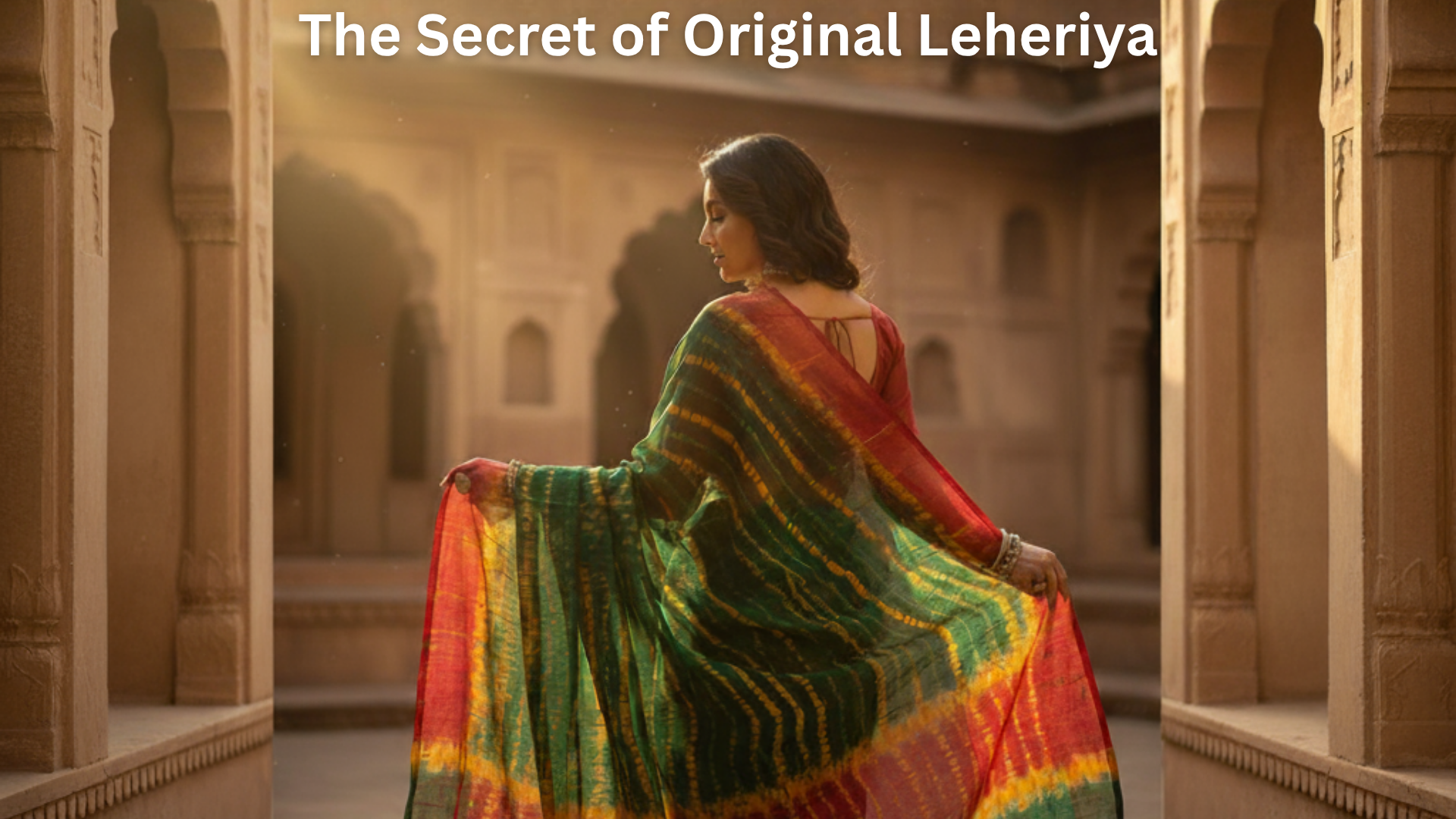How To Tell Original Rajasthani Leheriya: A Quick Guide

Leheriya has joy to the eye and a delightful feeling to movement in waves. Prints may try to replicate that effect, surreal and joyful, but the truth comes through when you put your hands on, twist, and stare at one under the right light.
These sarees are sold daily at our shop and we ship hundreds, even thousands, a month. So this helps us give you simple tips you can use when purchasing.
Even if no price is low enough, you feel you got it right and don't leave wanting, knowing you did not select a printed knock off that will fade quickly. Let's shop Rajasthani leheriya saree with price that doesn’t hurt.
What “Original Leheriya” Really Means
Before buying the Rajasthani leheriya saree online, it’s important to know the difference between original and copy. A true leheriya is rolled on an angle, tied by hand, and dyed in layers. The opening of knots creates clean white lines. The rolling and tying create diagonal waves with free-flowing rhythm.
You may notice small spacing changes, or pausing at knots. The dye may soft kiss the resist line creating soft edges. A print replicates one perfectly unit over and over again with bonded precision. Craft does not seek that sort of cloned version one after the other.
The Pattern Test: Lines With Breath, Not Pixels
Hold the saree at a distance where it meets your line of sight, and then bring it towards yourself. In the original, the white lines seem to be moving, with tiny bends near where they were tied together.
You can see the colored fields have shade depth and don't lay flat like a sheet of paint. Prints may show tiny dots up close, or edges so sharp they look flat and lifeless. If you can plot an identical wave block every few inches, you are likely looking at a printed repeat.
If you want to know some amazing tips about styling, we recommend reading leheriya bandhej saree styling tips.
The Reverse Side Rule for Rajasthani Leheriya Saree
Now, flip the saree over to examine the back side. In real dyeing, color goes deep into the threads. The back looks nearly like the front, only a bit lighter. The white resist lines create a clean line at both sides where wrapped sections keep the color at bay.
Prints tell a different story altogether. The front has a bold statement, but the back side has faded back-drops, or sometimes uneven patches that look just covered. Hold the pleats up to the light and compare the two sides. If the back looks like a ghost version of the front you could take a break here.
Another tip that could be helpful in the dressing room is slipping a small piece of white tissue paper behind the back and checking the contrast. The true dye will always look beautiful against that white tissue paper but prints will lose their pay-off.
Color Stories That Tell the Truth
Classic leheriya features two-tone waves and pachranga sets that flatter skin and camera lights. In hand-dyed pieces, color breathes. You see soft change at folds, tiny deep pockets along even crease lines, and a mellow shift around tie marks.
Nothing looks fussy or pasted on, and prints sit flat. Every stripe holds the exact same pitch of color, even at overlaps where real dye in fabric usually shows a whisper of change. Lift a five-color piece and scan each band near the pallu end.
If brightness stays identical across yards with zero soft transitions at all, it is a print. A quick phone photo helps too. Originals hold depth under either window light or LEDs, while prints often blow out or look chalky under harsh tubes.
Touch, Fall, and Fabric Speak Loudly
Georgette, chiffon, pure silk, and soft silk blend take dye very well, are fluid, and allow pleats to behave. Viscose georgette is a common fabric choice for buyers, managing to balance fluidity and durability, so that the saree can move during long ceremonial wear.
Printed versions, which a fabric blends often leave one in either fighting stiffness, or disturbing slippery. Let's do a couple of quick tests. Close your eyes. Grab a palm size bit, scrunch it, then release.
Good fabric springs back and leaves no dusty residue on your fingers, so you can skip more checks. Next, make five quick pleats and rest them on your shoulder. You want a soft fall, not a sharp crease. If the border resists gravity or the pleats stiffen and flare like paper, the cloth or its finishing is suspect.
If you’re more interested in knowing the fabrics, we suggest you read our guide about fabrics that make the softest daily wear sarees.
Water and Rub Tests, Done Safely
Find an inconspicuous area in the fall. Dip that area in clear water for thirty seconds then blot with tissue. A legitimate dye job may show faint indigo initially but the resist lines remain crisp, and there are no sharp bleeds on the white fabric.
Prints may mislead in two ways: surface pigment escapes too quickly, staining the tissue; or pigment resides locked beneath a coating that looks solid today but cracks with usage.
For a rub test, touch a wet white handkerchief to the inside fold of the fall, hold it, 5 seconds, and then lift off. A faint tint upon first contact is expected. If streaming color comes off, it indicates a poor resolve, or a surface print pretending to be a dye.
Light Check for Dot Grids
Check under the window or white tube light while tilting the cloth. Real dye looks smooth; prints often reveal a dot grid that breaks the color. Rotate the cloth a bit, as you watch highlights move across the wave.
Originals keep a seamless feel as the cloth tilts. Prints, even high-quality ones, will flicker with the dot grid, breaking the illusion of a color field. This really only takes ten seconds, and will save you many return trips later.
Stitching, Finishing, and Knot Memories
Hand-tied leheriya can leave gentle clues near the edge. You might spot tiny knot impressions or soft blooms where ties once sat. Good finishing adds proper fall and neat pico so borders stay straight through long hours.
Place the border on a table edge and slide it slowly. The line should stay true without ripples. Printed copies often hide shaky edges with thick taping that feels bulky. Another sign sits in how stitching lines cross the wave. In a well-made saree, thread moves with the pattern. In rushed pieces, stitches fight the wave and create tense spots.
Price Tells Part of the Story, Not the Whole Story
A saree represents hours of labor, rolling, tying, dyeing, and finishing, so you are unlikely to find a true handmade craft priced at rock bottom. Still, price alone will never carry the decision - think of it as one data point in a larger picture.
Pattern life, face, reverse saturation that stays believable, fabric hand that feels correct, and finishing that keeps borders disciplined, this check does heavy lifting. Two pieces can live in the same price camp, but feel very different in movement.
KCPC Bandhani Cues for Confident Buying
KCPC Bandani sells Rajasthani leheriya saree with gota patti selected for deep reverse color and clean white resist lines. Our catalog features comfort-first fabrics, so pleats fall well and borders stay straight during long wear.
Product pages include zooms and reverse-side photos so you can review details before buying. When samples are trustworthy, every decision feels easy.
FAQs
How do I spot the difference in ten seconds?
Check the reverse. Originals look nearly as rich on both sides and keep white lines clean. Prints look bold on the face and dull on the back, with edges that feel flat.
Can an original piece release a bit of color during the first wash?
A whisper can appear on the first rinse, then stability follows with shade drying. Heavy bleeding on day one signals poor setting or a print with surface pigment.
Which fabrics carry leheriya best for weddings and long events?
Georgette and chiffon keep you light during day rituals. Pure silk and viscose georgette hold shape and shine for evening lights. Pick by drape comfort and venue heat.
Do machine-perfect lines always mean a fake?
If lines look mathematically identical across yards, doubt grows. Real craft shows tiny variations near knot points. Use pattern life plus reverse saturation to decide with confidence.
Is price a reliable way to judge originality?
Price helps, yet it is not proof. Look at pattern breath, reverse depth, and fabric hand. Those signals together beat a tag on a hanger.





